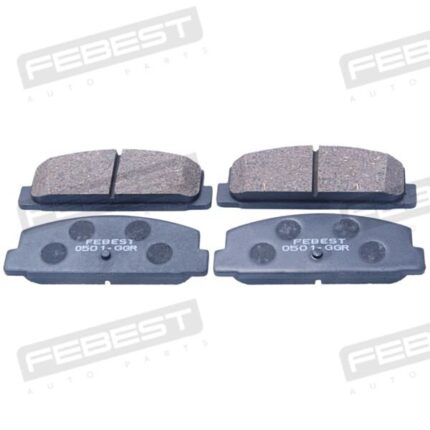-10%
Get Bush Kit, Small, Front Lower Arm Mark X GRX125, Crown GRS181/3 4WD
The front lower arm, also known as the lower control arm or wishbone, is a crucial component of a vehicle’s suspension system. It plays a significant role in supporting the weight of the vehicle, providing stability, and allowing for controlled movement of the wheels. Here’s a detailed overview of the front lower arm, its functions, components, and importance in vehicle dynamics:
Function of the Front Lower Arm:
- Suspension Attachment and Support:
- Connection Point: The front lower arm attaches the suspension components (such as the steering knuckle or spindle) to the vehicle’s chassis or subframe.
- Load Bearing: It bears the weight of the vehicle and provides support to the suspension system, helping to absorb shocks and vibrations from the road surface.
- Control of Wheel Movement:
- Range of Motion: The front lower arm allows the suspension to move vertically as the wheels encounter bumps, potholes, or uneven road surfaces.
- Controlled Movement: It helps maintain the proper alignment and orientation of the wheels, ensuring optimal tire contact with the road for safe and stable handling.
- Alignment and Steering Geometry:
- Alignment Adjustment: Some lower arms are equipped with adjustable bushings or camber bolts, allowing for fine-tuning of wheel alignment parameters such as camber and caster.
- Stability: Proper alignment facilitated by the front lower arm contributes to stable steering response and even tire wear.
- Impact Absorption and Damping:
- Shock Absorption: Along with other suspension components, the lower arm absorbs impacts and shocks from road irregularities, enhancing ride comfort for passengers.
- Vibration Damping: It helps dampen vibrations and oscillations, contributing to smoother vehicle operation and reduced noise levels.
Components of the Front Lower Arm:
- Arm Body: The main structural component of the lower arm, typically made from forged steel, aluminum alloy, or stamped steel for strength and durability.
- Bushings: Rubber or polyurethane bushings are used to mount the lower arm to the vehicle’s chassis or subframe. These bushings allow for controlled movement and help reduce noise and vibrations.
- Ball Joint: The ball joint connects the lower arm to the steering knuckle or spindle, allowing for articulation and steering movement. It provides pivot points for wheel rotation and steering.
- Mounting Hardware: Bolts, nuts, and washers secure the lower arm assembly to the vehicle’s chassis or subframe, ensuring proper attachment and stability.
Importance in Vehicle Dynamics:
- Handling and Stability: The front lower arm plays a crucial role in maintaining vehicle stability and predictable handling characteristics, especially during cornering and maneuvering.
- Safety: A properly functioning lower arm ensures that the wheels remain securely attached to the vehicle and aligned correctly, contributing to safe driving conditions.
- Comfort: By absorbing shocks and vibrations, the lower arm enhances ride comfort for passengers, minimizing the impact of road imperfections.
signs of a worn out Front Lower Arm;
1. Clunking or Knocking Noise
- Description: A common symptom of worn lower control arms is a clunking or knocking noise when driving over bumps or rough roads.
- Cause: Worn bushings or ball joints within the control arm can allow excessive movement or play, causing components to knock against each other or against the vehicle’s chassis.
2. Steering Wheel Vibration
- Description: Worn lower control arms can cause vibrations in the steering wheel, especially at higher speeds or during acceleration.
- Cause: Excessive play or looseness in the control arm bushings or ball joints can lead to steering wheel vibrations, as the suspension components are not properly stabilized.
3. Uneven Tire Wear
- Description: Worn lower control arms can affect wheel alignment, leading to uneven tire wear patterns.
- Symptoms: Look for signs such as excessive wear on the inner or outer edges of the tires, which may indicate alignment issues caused by worn control arm bushings or ball joints.
4. Steering Instability or Wander
- Description: A vehicle with worn lower control arms may feel unstable or wander while driving, especially at highway speeds or during cornering.
- Symptoms: The steering may feel loose or require constant corrections to maintain a straight path, indicating compromised suspension control.
5. Steering Pull or Drift
- Description: Worn lower control arms can cause the vehicle to pull to one side or drift unexpectedly during driving.
- Cause: Uneven wear or play in the control arm components can affect wheel alignment and steering geometry, leading to directional instability.
6. Difficulty Steering or Turning
- Description: As wear progresses, lower control arms may affect the vehicle’s ability to steer or turn smoothly.
- Symptoms: You may experience stiffness in steering, requiring more effort to turn the wheel, or reduced responsiveness when maneuvering.
7. Visible Damage or Movement
- Description: In some cases, visual inspection may reveal signs of physical damage, corrosion, or excessive movement in the lower control arm components.
- Symptoms: Check for cracked or torn bushings, worn ball joints, or rust on the control arm itself, which can indicate imminent failure or compromised structural integrity.
8. Suspension Noise
- Description: Worn lower control arms may produce squeaking, creaking, or groaning noises, particularly during suspension compression or when turning the steering wheel.
- Cause: Lack of lubrication or worn-out bushings and joints can cause friction and noise within the control arm assembly.
9. Vehicle Lowered Ride Height
- Description: A vehicle with worn lower control arms may sit lower than usual, especially on one side.
- Cause: Worn control arms may allow the suspension to sag or settle unevenly, affecting ride height and ground clearance.
Follow us on Facebook For more parts.



